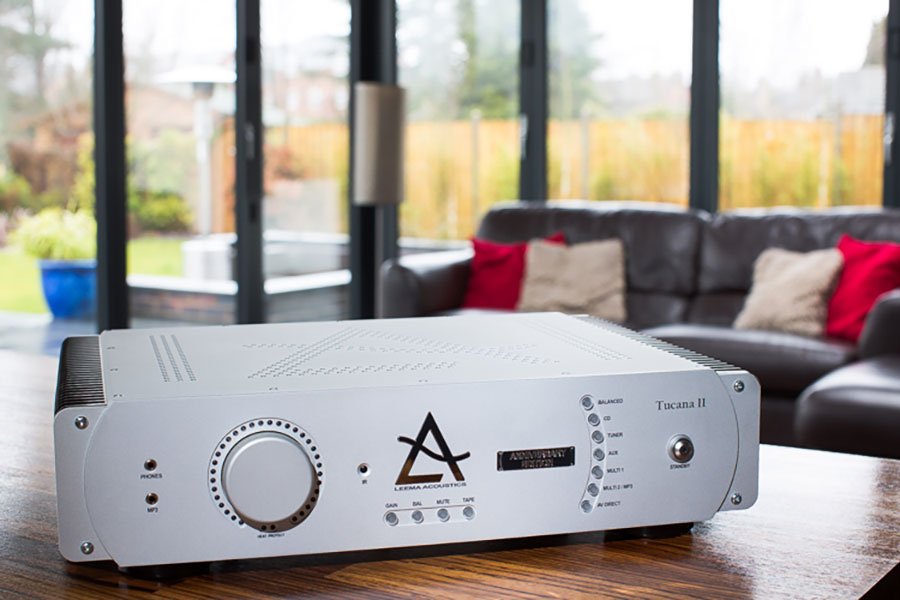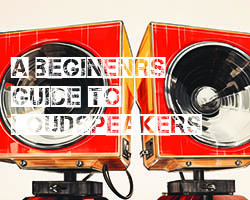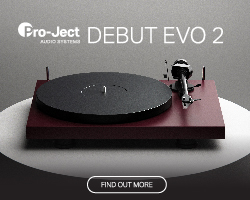Leema Acoustics, based in Wales have launched an Anniversary edition of their well received Tucana II integrated amplifier. Hifi Pig takes a listen. 
I recall having evaluated some Leema products before for Hifi Pig, namely their Elements integrated amplifier and Libra DAC, then more recently the Tucana Mark II integrated amplifier. I was pretty impressed with the Tucana II, so while the memory of that amplifier’s performance was still fresh in my recollection Leema sent me over their “Anniversary Edition” for review. It is a statement product to celebrate 10 years of being in business and my word the company has moved on in leaps and bounds during that relatively short period and their passion is clearly evidenced in their products, particularly so this product.
CONSTRUCTION
Like all other Leema electronics, the Tucana Anniversary Edition amplifier is built like the proverbial out-house and there is nothing at all flimsy or cheap in it’s build quality. Ergonomically too it is an absolute peach to operate, with all controls and indicators working flawlessly and reliably too for good measure. I particularly loved the volume control with it’s circle of LEDs to indicate the exact setting. Not the approximate setting mind, but the EXACT setting, which I will explain in due course, but I will say it is just about the best I have found on a modern amplifier with a digital volume control, as I hate with a passion any volume control that needs the skilled hands of an open heart surgeon to get an accurate volume setting. Very well done, Leema.
Outwardly, the new Tucana amplifier looks no different to either of it’s two predecessor (Tucana Mark 1 and 2), but the Anniversary Edition moves up a big notch over the “Tucana II” model, with a shiny badge denoting that it is the Anniversary Edition and bright silvered Leema logo on the faceplate, which easily sets it apart from the Tucana II which has neither of these adornments.
Taking a tour around the outward physical aspects then, the volume control knob is surrounded by 2 small coloured LED’s marked HEAT and PROTECT which are self explanatory and the PROTECT LED flashes 3 times during power up to show the circuitry is working, then the 32 small blue LED’s which flash 8 times during the power up sequence. It is interesting to note that the volume control is quite a complex circuit consisting of a 32 bit microprocessor plus an expensive high resolution encoder and some complex mathematics to arrive at 0.5dB increments on the volume control, which in use is utterly seamless.
To the left of the volume control we find two 3.5mm sockets for headphones connection and MP3 signal input, then to the right of the volume control we find the infra red remote control window, then to the centre of the front panel we find a series of four illuminated push switches labeled “GAIN”, “BAL”, “MUTE” and “TAPE”. To the right we have a set of seven illuminated push buttons for source selection, labeled “BALANCED”, “CD”, “TUNER”, “AUX”, “MULTI 1”, “MULTI 2 / MP3“ and “AV DIRECT”. Finally, we find the mains power/standby button which has a blue LED which illuminates in standby mode, which thankfully isn’t too bright in ambient light although it throws quite a pencil beam across the room as I discovered one night when I went into my darkened listening room for a pair of glasses and didn’t switch any lights on.
To the rear we find reading from left to right, a pair of loudspeaker binding posts for the right hand speaker, then two LIPS sockets which connects to other Leema products with the same connections for system control, then a mains IEC inlet socket, then a pair of balanced XLR input sockets, then below these connections we find a row of single ended RCA sockets labeled “TAPE” (input and output), “AV”, “MULTI 2” and “MULTI 1”, “AUX”, “TUNER””CD” and “PRE OUT”. All of the inputs have individual gain settings. Finally there is another pair of loudspeaker binding posts for the left hand speaker.
On the subject of speaker binding posts, I found some clear plastic shrouds fitted to the posts which prevented me using my main speaker cables with spade connectors fitted and the handbook/instruction manual clearly states that banana plugs are to be used for speaker connections to the amplifier. I can only presume that some jobsworth safety “experts” have deemed that using spade connectors to an amplifier now poses a serious health and safety risk in some way so they have been banned. It was more than annoying when they decided to put plastic plugs into speaker binding posts to stop the use of banana plugs, but if they have now added spade connectors to that banned list or so it appears, then how the heck are we supposed to connect loudspeaker cables???? I despair at the so-called nanny state, I really do. Because the amplifier produces 35 volts with immense current delivery at the speaker terminals, so US and EU rules dictate these shrouds must be fitted, so if I ever became fortunate enough to own one of these amplifiers I would remove them immediately and Leema can supply instructions for safely doing so. That of course is the owner’s decision and at their own risk, but Leema are simply complying with these statutory directives.
A silvered logo and a shiny badge doesn’t exactly justify a £1,000+ price hike over the price of a standard Tucana II model, so that begs the question what have Leema done to the product to differentiate it from it’s cheaper sibling?
The components are not rolled on the thighs of dusky maidens dressed in coconut shells and grass skirts during production, if that’s what you are thinking. No sir. Under the hood there is a list of worthwhile enhancements going on, like extra thick gold plated copper tracks on the PCB’s for increased conductivity, all capacitors within the signal paths are upgraded to Nichicon Muse, mains transformers are much bigger Noratel Xtraquiet types wound for low mechanical and electrical noise and Leema’s own 16 core Reference 2 cables are used as hook up wire to connect PCB’s to external connectors. I am told they are not the easiest cables to strip and solder, with no less than 64 cable ends to prepare, so the production build team deserve a medal for their patience and fortitude.
Included with the amplifier is Leema’s new Focus remote control handset and this too has Leema’s fastidious attention to detail written all over it. It took me a while to familiarise myself with the button layout, as the volume adjustment buttons are spang in the middle amongst other buttons and I had to look before pressing to make sure. Not one microgramme of plastic here folks, it is a heavy lump of alloy casting supported on four small rubber feet, with buttons that work positively and a nice touch for me was the LEDs which light up on the function selected. It is rather heavy and has it’s own microclimate surrounding it as well, as even in a warm room it is still cold to the touch. The weight is impressive too and I amply demonstrated that when my dog tried to steal my digestive biscuit, but a light tap on the cranium with the remote control meant he desisted immediately and slunk off, sans biscuit and didn’t risk another attempt at cookie larceny. No animals were permanently harmed during the writing of this review.
I was inspecting the underside of it and noted the lack of a battery compartment cover and any visible screws to change the batteries which are 2 x AAA type. Checked the owner’s manual and no mention is made of battery replacement, but the secret is to unscrew the 4 rubber feet and voila, the rear panel comes off complete. Leema will hopefully now include that information in the owner’s manual, as it has already perplexed some owners apparently. The remote is built from scratch in house, using miniature push switches rated for 10,000,000 presses and let me assure you all I didn’t put that claim to the test. The case is machined for Leema by a company in Oxfordshire and the text is laser etched in Hampshire. Bead blasting and anodising is carried out in Buckinghamshire. Boy, is this thing engineered and well travelled too for good measure it seems.
I found the external appearance of the amplifier very refreshing in not being the same boring flat sided rectangular box with knobs on the front, as it was running outwith of the mainstream herd’s appearance and instantly recognizable as a Leema product. Sort of reminds me of the Monty Python sketch “How to recognize a Larch tree from a distance”, so all I had to do was swap the word Larch for Leema. Not a Python fan? Please yourselves.
SOUND QUALITY
Press the standby button on the front panel and the amplifier begins it’s powering up routine. The Protect LED flashes 3 times, then the 32 blue LEDs surrounding the volume control flash 8 times and the volume resets to a preset low level.
With a specification rating capable of delivering 150 watts per channel in to 8 ohms and 290 watts into 4 ohms and can also muster 520 watts into 2 ohms no less, it would suggest a very powerful amplifier and so it proved to be during the listening sessions. Lee Taylor (The LEE of LEEMA) tells me that the amplifier is impervious to load impedance vagaries and will easily drive those “difficult” speakers whose impedance curve drops below 1.5 ohms, in fact he says it will drag music out of a rusty nail if needs be. I will take his word on that, but I get his meaning, if not in the strictest literal sense of course.
In one word I would describe it as “muscular”, but not in a brutish way at all and you could liken that level of power with a champion bodybuilder, in that you wouldn’t start a fight with him as you know you would lose before you began and him knowing his own strength so he doesn’t have to prove it to anyone, least of all you. Just measure his biceps and be very nice to the man.
That solid power of course manifests itself in bass output, whereby a drum sounds like a drum at close range, losing none of the heft and power that’s there, including the harmonics generated by the drum’s shell. My resident power amp is rated at 200 watts per channel, but it easily lost to the Leema unit in the way the power was delivered, with a firm depth of solidity that was perceived as just slightly lacking in my own amplifier. Both amps could deliver the “punch in the guts” power from a kick drum beat, but the Leema took that one stage further by allowing you to hear what the drum skin and shell was doing, very clearly and very concisely, plus whether a hard or soft beater was being used. All the while the amplifier is dealing with delivering high power for bass energy, it still does not lose the plot in nuances and fine details and as such it is pretty much unruffled whatever genre of music you throw at it and that is in essence why the Leema Tucana Anniversary Edition has so few rivals.
With the arrival of a pair of Audiovector SR3 Avantgardes for review, this was a pairing that just HAD to happen. I had a brief hearing of these speakers at the 2017 Bristol Hifi Show being driven by a compact Exposure system. During this particular visit to the show I had lurking in my prized Hifi Pig pink shoulder bag some of my own CDs in the hope some exhibitors could tear themselves away from their library of specially selected plinky plonk music and give my offerings a whirl. Of course, I had in my bag Fink’s “Wheels Beneath My Feet” album which I was itching to be played and the results I heard at Bristol were nothing like what I was used to at home with the exception of one room, the Exposure room using the Audiovectors. That began my quest to review a pair of these speakers and happy to say Audiovector were more than happy to oblige, so look out for the full review of these speakers soon in Hifi Pig Magazine.
The Leema amplifier and the Audiovector SR3s were a very sweet listen indeed. Notice I use the word “sweet” here and they were a joy to listen to. Smooth flowing, very powerful and yet highly controlled, bass in particular was a solid as a brick wall, completely unshakeable in fact. I never once found the sound lacklustre or laid back either let me add, this pair didn’t fatigue either and I could listen for many hours and be completely absorbed by the sound. The very top end treble didn’t have the clarity and dynamics for my own personal listening preferences, but I do know many of our readers intensely dislike sharp defined treble registers, so if you belong to this group of people, then be heartened in the knowledge this pairing would please you tremendously. As an add-on to this although not entirely relevant to this review, I recently bought a Lyngdorf power amp with 200 watts on tap and the bass sounded decidedly off with the Audiovector Avantgarde SR3s and worse still, I couldn’t fathom out why. This hifi caper has it’s inexplicable quirks at times.
Another pair of speakers in for review was a pair of hORNS Aria 1 speakers, so it would be rude not to harness them to the Leema amplifier as well while they were here. In my resident system, the hORNS had a rather subdued bass offering, with sublime treble and midrange which more than compensated for that. Paired to the Leema amplifier though, the bass registers certainly perked up, producing a better balanced sound from top to bottom ends of the spectrum. Synergy at play here methinks and I would say that the bass softness of the Arias were better matched to the strong power delivery traits of the Leema amplifier.
I also have a pair of Roksan TR5 speakers here and they too were connected to the Leema amplifier. I was amazed that out of the 4 pairs of speakers connected to the Leema, these were the best tonally balanced out of the 4. Neither bass nor treble dominated proceedings and they managed to walk that fine line between exciting and dynamic and overblown and overpowering. This meant you could enjoy an extended listening session without becoming jaded or fatigued.
Then we move on to my current resident speakers, the Pylon Diamond Monitors I reviewed earlier this year for Hifi Pig and had to have after hearing them in action. These speakers deserve the epithet “Monitors” and really do live up to their name. They are fast, dynamic, insightful and tuneful, with a bass output that you wouldn’t expect from a box of their relatively small size and they easily ousted my then floor standing speakers with ease. The best thing about these speakers is they are a great reviewing tool as well, because what you feed into them is very clearly heard, warts and all. When plumbed up to the Leema amplifier, the character of the Leema changed completely. What perked up the hORNS speakers and was “sweet” with the Audiovector SR3 Avantgardes was no more, instead I got a lively and punchy amplifier with a tremendous amount of accuracy and refinement in the midband and treble region, with micro dynamics portrayed excellently. I love these speakers because of their in your face, bite your shins kind of presentation and they pull no punches which I personally adore, but may not be to other’s tastes and I am very comfortable with that. As with the hORNS Aria 1 speakers the Leema amplifier addressed and married well with the speakers, whereas with the Pylon speakers it was the other way around in my perception with the Leema amplifier then was a prime case of ripping of the sheep’s clothing and finding the wolf hiding underneath.
Needless to say, the Leema comfortably passed every benchmark recording I fed into it and when it came to Fink’s “Wheels Beneath My Feet” album, I kid you not I played that album five times in a row just for the sheer pleasure of it and the thought of using the album as a “test” soon disappeared.
AT A GLANCE
CONCLUSION
My recollection of the Tucana Mark II amplifier was that it was just a tad finicky about what speakers it was paired with to give of it’s best. The Tucana Anniversary Edition was happy with whatever speakers it was paired with and the best part for me was being able to crank up the volume control with not the slightest trace of blare, no matter how high the sound level increased, in fact my hearing was at it’s topmost level of tolerance, yet the amplifier sounded like it wasn’t even breaking into a sweat. I cannot recall any amplifier being able to do that, although some have come close.
The sound is truly effortless in every respect and I really do admire it’s ability to untangle really complex music and keep it all firmly in it’s place without getting knotted up in the slightest.
I personally gave the Leema Tucana II a highly, highly, highly recommended nomination, as it justly deserved it, but this amplifier is far more than that, therefore has to be handed over to a second reviewer for their analysis before we start thinking about an Outstanding Product award from Hifi Pig.
Build Quality: In the price band the Tucana occupies, it is a class leading amplifier.
Sound Quality: Peerless.
Value For Money: I can easily see this as a long term keeper amplifier, so will save money during it’s lifetime by not “upgrading”. The build is worth every penny on it’s own.
Pros: Superb build and sonic attributes make this a must audition product.
Cons: Not cheap by any means, but true quality never is. Refine your busking skills or sell a kidney if you are a true audiophile.
D Marsh
Dominic was impressed enough by the Leema Acoustics Tucana II Anniversary Edition to put it forward for a Hifi Pig Outstanding Product award. To qualify, the amp had to be reviewed by a second Hifi Pig reviewer and so the Tucana II Anniversary Edition was passed to John Scott for his thoughts.
Domonic has already done a sterling job in describing the background to the Tucana II Anniversary Edition, its features and operation so there is no point in me repeating any of that, although I will provide a few impressions of the amp’s appearance and set up.
UNBOXING AND SET UP
I wasn’t at home when the Tucana II was delivered and apparently the delivery man was none too happy at having to lug it up the garden path. When my better half answered the door, he asked her to sign for receipt and then clearly intended to leave it on the doorstep. When Mrs S explained that she wouldn’t be able to move it from there, he grudgingly carried it the extra 2 feet into the hallway where I found it awaiting my arrival when I got home.
There’s no denying that in its sturdy cardboard packing case the Tucana II is a bit of a handful but I manhandled it into the living room without too much difficulty and proceeded to unbox it. The amp comes cosseted in a drawstring bag which is useful if you need to store it temporarily for any reason.
As Dom has mentioned, the amp is solid in every respect and the build quality is first class. It has the look of something that would be at home in a recording studio but its understated elegance also fits in perfectly to a domestic environment. Set up was as straightforward as you would expect an integrated amplifier to be and I had it up and running in a matter of minutes. I knew that as it had been tested extensively by Dom that it would not require any run in time but I gave it a couple of hours just to warm up anyway.
SOUND QUALITY
Dom has explained above about the 32 blue LEDs that surround the volume control. I should explain that these LEDs start at roughly the 7 o’clock position, at which the volume is zero, round to roughly 5 o’clock, at which maximum volume is produced. I have a pretty big listening room by modern standards but at no time during the weeks I spent with this amp was I able to get it past the 9 o’clock position – The Tucana II is capable of some serious volume!
Volume aside, the Tucana II’s defining characteristic is detail. It is, in fact, the most forensically detailed amp I have encountered; this was particularly notable in the way in which it revealed reverberation tails and details of room acoustics that had been previously hidden. This aspect of its performance proved initially to be slightly disconcerting; I’d settle down to enjoy an album I knew well and find that it sounded different to how I remembered it – sometimes not necessarily better and sometimes not necessarily worse, but decidedly different and It took a few listening sessions before I got used to this.
I found myself being drawn more to the electronic music in my collection as the Tucana II revealed new tones and textures in the synthesised instruments; The Ballet Of The Chicks In Their Shells from Isao Tomita’s version of Mussorgsky’s Pictures At An Exhibition fairly burst from my Audio GE Sincerous 80 floorstanders and danced around in front of me in a way I hadn’t experienced before. Every second of the ride on Kraftwerk’s Autobahn, from ignition to journey’s end was a thrill.
Christy Moore’s version of The First Time Ever I Saw Your Face has some deep bass which can, in the wrong system, swamp the playback entirely and render it, boomy, muddy and generally unlistenable. The Tucana II kept tight control, delivering the bottom end in its entirety but never at the expense of Moore’s and Declan Sinnott’s guitars and vocals.
The Tucana II makes “spot the mistake” a fun game to play; the join between two different recordings at 1:24 in John Lennon’s Working Class Hero from the Plastic Ono Band album is more clear to hear than ever. Similarly, in Steve Winwood’s While You See A Chance from his Arc Of A Diver album, there’s a dodgy overdub at 3:54 that stands out like the proverbial sore thumb.
AT A GLANCE
CONCLUSION
Leema Acoustics’ Tucana II Anniversary Edition amplifier delivers an audio performance that is as solid as its build quality. It will bring out the best, and the worst, of whatever other bits of kit you partner it with and with the recordings you play through it. For that reason I’m just slightly more guarded in my enthusiasm for the Tucana II than Dominic is as I believe that correct system matching will be critical to how it performs in your listening room. That said, the amp’s honesty and transparency means that it will be a component that will happily deliver great performance now and will maximise the benefits of any upgrades you may make in the future. On this basis, I am more than happy to support its nomination as a Hifi Pig Outstanding Product.
Build Quality – As solid and well-finished as they come at this price point.
Sound Quality – Effortlessly revealing, this amp just tells it like is.
Value for Money – Not cheap but if you like what it does, it’s a keeper.
Pros – That honesty and transparency thing.
Cons – That honesty and transparency thing; it doesn’t suffer fools gladly and it won’t be to everyone’s taste.
John Scott
SPECIFICATIONS:
Output Power: 150W rms 8 Ohms/Channel
Output Power: 290W rms 4 Ohms/Ch
Output Power: 520W rms 2 Ohms/Ch
THD: 0.004%
Noise: < -100 dB
Frequency Response: 5 Hz – 100 kHz (+0/-3 dB)
Number of balanced Inputs (XLR): 1
Number of un-balanced Inputs (RCA): 6
Tape Input: 1
Tape Output: 1
MP3 Inputs: 1
Headphone Outputs: 1
Pre-out Outputs: 1
Channel gain adjust for each individual input
Mute Button: Yes
Balance Adjust: (left/Right)
Thermal Protection: Yes
LIPS® system: Master or Slave
LIPS® system: Master or Slave
Dimensions: 440*320*110mm
Carton: 590*450*210mm
Weight: 18Kg
















































































































































































































You must be logged in to leave a reply.